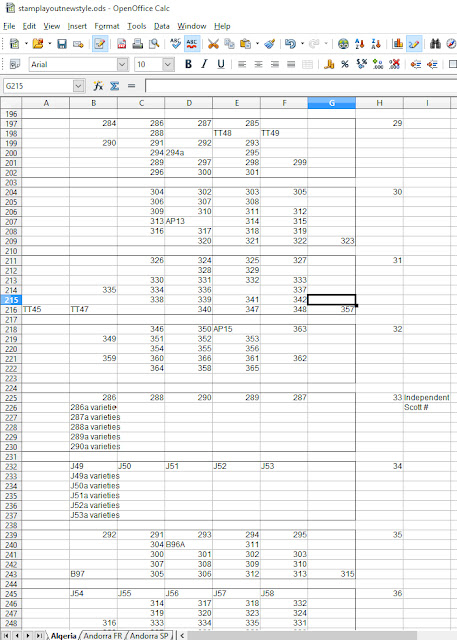Those of you who have followed my blog over the past year or so know that I house my collection on Vario Stockpages. You also are quite aware of my fondness for specialized catalogs and my desire to organize my collection so that it is easy to fit in varieties listed in specialized catalogs along with the "mainstream" stamps listed in the general catalogs such as Scott.
I thought I had worked out an excellent system. I would create a "key" using a spreadsheet program to create "pages" that would reflect the content on the Vario pages I had or would include in my albums. Once made I could print these outlines out on paper and place them in the back of the correct album.
I would thus have a paper copy with my albums, plus a digital copy I could save. And the result was this setup :
Algeria Key that I had set up in a spreadsheet and then printed out.
Then a disaster happened - the original master copy I had created with ALL of the album layouts I had developed (around 60 different countries by that point) became corrupted and I could no longer access it.
So I came to a fork in the road - do I re-enter all that data and had lost, or go in a different direction in terms of how I created a "key" that would let me know where stamps would go on a Vario page.
I decided on the latter course, in part because the old system had one major flaw - it was difficult to include more than one catalog number per cell without the page being confusing. Also, it did not really provide an easy way to know what the exact nature of the "varieties" would be.
So, I started rethinking the idea of how best to create a system that would accomplish all of the following
- Show Catalog Numbers for both Scott and whichever specialized catalog I used for that nation, if any.
- Indicate what exactly the variety for minor-number listings of stamps were - was it a new color shade, a new perf type, a constant plate variety?
- Provide a little information about what the stamp depicted or commemorated. This was something I had thought I would not really need, but over time I did miss this element that you get with album pages.
To accomplish these goals I realized I needed to provide the information much closer to the actual stamps in the album, not simply printed at the back of the album.
My first idea was to create small tags that I could insert next to each stamp. Then all the information would be right there with the stamp. After a bit of playing around I found that spreadsheet programs would work best to create these tags and then I could just print them out (on acid free paper) and insert into album next to stamps.
This was the result
Page from my Algeria album with the "tag" idea implemented
It does fulfill the three requirements I listed above, and would remove any doubt to any future dealers who might end up with my stamps as to what I have.
After getting some collector feedback from the various stamp bulletin boards, however, I came to realize one thing - the tags were definitely overshadowing the stamps. As the owner of Stamp Boards commented, it looked like I was "collecting paper tags" as well as stamps. And he was right.
Plus, there is one other consideration here - you can print out a page of tags onto acid free paper, but you still need to separate them, which means a lot, and I mean a great deal, of cutting with scissors. Thinking about all the albums I have and plan to make in the future, I could already feel my hands starting to cramp up!
Then a collector on the Stamp Boards forum made a comment about how the Stanley Gibbons albums were organized. The stamps are only on the right side of the page, with catalog information and illustrations provided on the left page opposite. (this is also the setup I believe Mystic uses in its USA albums). So the albums look something like this
Stanley Gibbons "Imperial" album setup :
Illustrations and text one side, the stamps themselves opposite
It was the "Eureka" moment I was looking for. This kind of setup would achieve the three goals I wanted to achieve with the information, but not make the pages so cluttered that it distracts from the stamps themselves.
And this is the result
Page from my Algeria album with the info page opposite to the stamps.
The look is I think quite clean, yet provides all the relevant information I need at a quick glance - which stamps do I need, where does it go on the page, what is its catalog number, why is it a variety.
Now since Vario pages are 2 sided, the way I will lay out my albums will be to have a double-sided info page inserted between two Vario pages. Print out on acid free paper, place into a page protector, and voila, done. No fiddly cutting tags!
So now I am in the process of creating these info pages for my albums. Yes it will be a lot of work, but since my base file corrupted, I have to do it anyways, and it's a fun project that helps me learn more about what the various specialized catalogs include. Plus, when money is tight and I can't spend a lot of money on stamps themselves, this is a cheap way to enjoy philatelic time.



